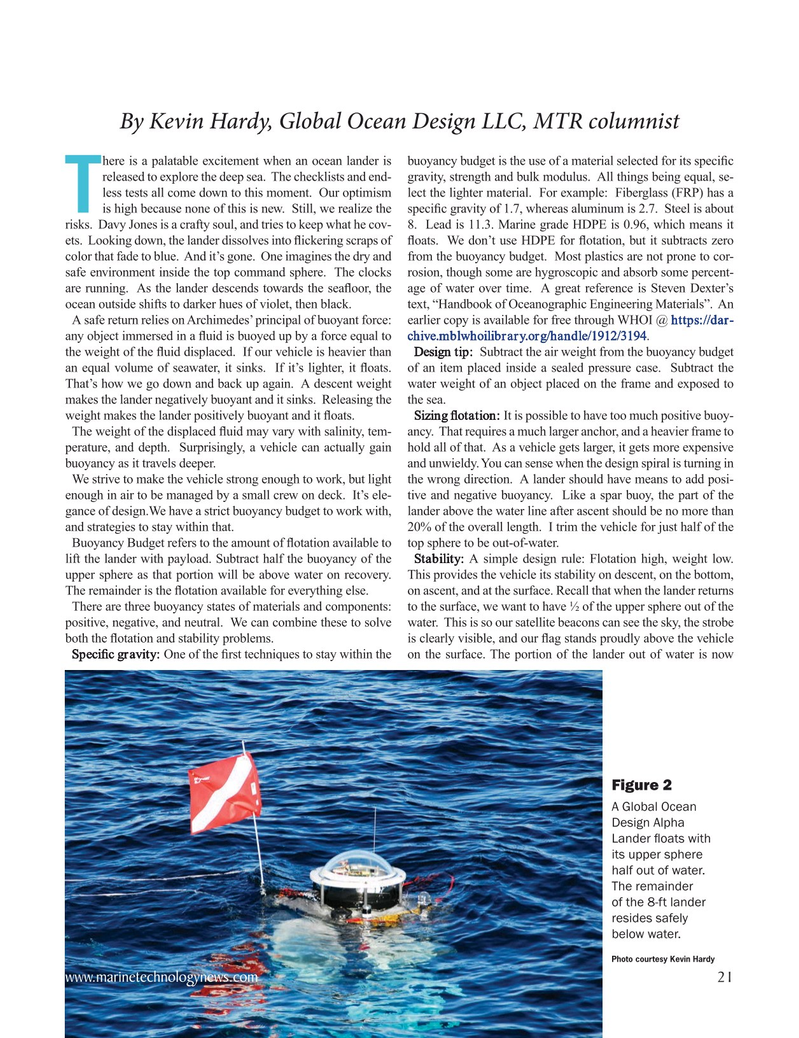
Page 21: of Marine Technology Magazine (May 2022)
Read this page in Pdf, Flash or Html5 edition of May 2022 Marine Technology Magazine
By Kevin Hardy, Global Ocean Design LLC, MTR columnist here is a palatable excitement when an ocean lander is buoyancy budget is the use of a material selected for its speci? c released to explore the deep sea. The checklists and end- gravity, strength and bulk modulus. All things being equal, se- less tests all come down to this moment. Our optimism lect the lighter material. For example: Fiberglass (FRP) has a
Tis high because none of this is new. Still, we realize the speci? c gravity of 1.7, whereas aluminum is 2.7. Steel is about risks. Davy Jones is a crafty soul, and tries to keep what he cov- 8. Lead is 11.3. Marine grade HDPE is 0.96, which means it ets. Looking down, the lander dissolves into ? ickering scraps of ? oats. We don’t use HDPE for ? otation, but it subtracts zero color that fade to blue. And it’s gone. One imagines the dry and from the buoyancy budget. Most plastics are not prone to cor- safe environment inside the top command sphere. The clocks rosion, though some are hygroscopic and absorb some percent- are running. As the lander descends towards the sea? oor, the age of water over time. A great reference is Steven Dexter’s ocean outside shifts to darker hues of violet, then black. text, “Handbook of Oceanographic Engineering Materials”. An
A safe return relies on Archimedes’ principal of buoyant force: earlier copy is available for free through WHOI @ https://dar- any object immersed in a ? uid is buoyed up by a force equal to chive.mblwhoilibrary.org/handle/1912/3194.
the weight of the ? uid displaced. If our vehicle is heavier than Design tip: Subtract the air weight from the buoyancy budget an equal volume of seawater, it sinks. If it’s lighter, it ? oats. of an item placed inside a sealed pressure case. Subtract the
That’s how we go down and back up again. A descent weight water weight of an object placed on the frame and exposed to makes the lander negatively buoyant and it sinks. Releasing the the sea.
weight makes the lander positively buoyant and it ? oats. Sizing ? otation: It is possible to have too much positive buoy-
The weight of the displaced ? uid may vary with salinity, tem- ancy. That requires a much larger anchor, and a heavier frame to perature, and depth. Surprisingly, a vehicle can actually gain hold all of that. As a vehicle gets larger, it gets more expensive buoyancy as it travels deeper. and unwieldy. You can sense when the design spiral is turning in
We strive to make the vehicle strong enough to work, but light the wrong direction. A lander should have means to add posi- enough in air to be managed by a small crew on deck. It’s ele- tive and negative buoyancy. Like a spar buoy, the part of the gance of design.We have a strict buoyancy budget to work with, lander above the water line after ascent should be no more than and strategies to stay within that. 20% of the overall length. I trim the vehicle for just half of the
Buoyancy Budget refers to the amount of ? otation available to top sphere to be out-of-water.
lift the lander with payload. Subtract half the buoyancy of the Stability: A simple design rule: Flotation high, weight low. upper sphere as that portion will be above water on recovery. This provides the vehicle its stability on descent, on the bottom,
The remainder is the ? otation available for everything else. on ascent, and at the surface. Recall that when the lander returns
There are three buoyancy states of materials and components: to the surface, we want to have ½ of the upper sphere out of the positive, negative, and neutral. We can combine these to solve water. This is so our satellite beacons can see the sky, the strobe both the ? otation and stability problems. is clearly visible, and our ? ag stands proudly above the vehicle
Speci? c gravity: One of the ? rst techniques to stay within the on the surface. The portion of the lander out of water is now
Figure 2
A Global Ocean
Design Alpha
Lander ? oats with its upper sphere half out of water.
The remainder of the 8-ft lander resides safely below water.
Photo courtesy Kevin Hardy www.marinetechnologynews.com 21
MTR #4 (18-33).indd 21 4/25/2022 10:12:11 AM

 20
20

 22
22
